Inversion and mapping of soil alkali-hydrolyzable nitrogen in farmland using satellite remote sensing and machine learning
IF 6.1
1区 农林科学
Q1 SOIL SCIENCE
引用次数: 0
Abstract
Soil alkali-hydrolyzable nitrogen (SAN) is a crucial indicator of soil nutrient status. Quickly and accurately obtaining the spatial distribution of SAN content is essential for the effective implementation of precision variable fertilization. To efficiently estimate SAN content at the field scale and improve the model's accuracy and stability, the basic farmland of Jianshan Farm in Heilongjiang Province was selected as the study area. Remote sensing factors and topographic variables were extracted from Sentinel-2 satellite imagery and Copernicus digital elevation model. Simultaneously, SAN content was measured during different bare soil periods in spring and autumn. This study employed support vector regression (SVR), extreme gradient boosting (XGBoost) and BP neural network (BPNN) to establish SAN content inversion models for different bare soil periods. Then, the zebra optimization algorithm (ZOA) was used to optimize the hyperparameters of the best-performing model, and the experimental results were analyzed. Finally, the model's interpretability and reliability were validated through feature importance analysis and statistical significance tests. The results indicated that the correlation between the raw bands of remote sensing data in autumn and SAN content was generally higher than that in spring. The spring SAN inversion model, ZOA-XGBoost-2, which incorporates raw bands and topographic variables demonstrated the best predictive performance (R2=0.3416, r = 0.6153, RMSE=31.1616 mg/kg, MAE=21.2132 mg/kg, MAPE=7.5184 %). The autumn SAN inversion model, ZOA-BPNN-6, based on raw bands, vegetation indices and topographic variables demonstrated the best predictive performance (R2=0.7304, r = 0.8664, RMSE=20.3511 mg/kg, MAE=15.5451 mg/kg, MAPE=5.2008 %). Compared with the unoptimized inversion model, R2 increased by 6.32 percentage points and 1.12 percentage points, and r increased by 3.99 percentage points and 1.01 percentage points, respectively, while RMSE, MAE and MAPE decreased. In the spring model, vegetation indices and raw bands accounted for 52.82 % and 47.18 % of the total importance, respectively, while in the autumn model, raw bands, vegetation indices, and topographic variables contributed 46.15 %, 30.72 %, and 23.13 %, respectively. In addition, ANOVA confirmed that the model performance differed significantly between the two seasons, validating the superiority of the autumn model in SAN prediction. The proposed inversion model yielded better prediction results, which closely aligned with the actual SAN data. It can provide a theoretical basis and technical support for the rapid and dynamic monitoring of soil nitrogen content at the farm scale, as well as for variable fertilization decision-making.
基于卫星遥感和机器学习的农田土壤碱解氮反演与制图
土壤碱水解氮(SAN)是反映土壤养分状况的重要指标。快速准确地获取土壤中SAN含量的空间分布,是有效实施精准变量施肥的关键。为了有效估算农田尺度上的SAN含量,提高模型的准确性和稳定性,选择黑龙江省尖山农场基本农田作为研究区。利用Sentinel-2卫星影像和哥白尼数字高程模型提取遥感因子和地形变量。同时测定了春、秋两季不同裸土时期的SAN含量。本研究采用支持向量回归(SVR)、极端梯度增强(XGBoost)和BP神经网络(BPNN)建立了不同裸土时期SAN含量的反演模型。然后,利用斑马优化算法(ZOA)对性能最优模型的超参数进行优化,并对实验结果进行分析。最后,通过特征重要性分析和统计显著性检验验证模型的可解释性和可靠性。结果表明:秋季遥感数据原始波段与SAN含量的相关性总体高于春季;结合原始波段和地形变量的spring SAN反演模型ZOA-XGBoost-2预测效果最佳(R2=0.3416, r = 0.6153,RMSE=31.1616 mg/kg, MAE=21.2132 mg/kg, MAPE=7.5184 %)。基于原始波段、植被指数和地形变量的秋季SAN反演模型ZOA-BPNN-6预测效果最佳(R2=0.7304, r = 0.8664,RMSE=20.3511 mg/kg, MAE=15.5451 mg/kg, MAPE=5.2008 %)。与未优化的反演模型相比,R2提高了6.32个百分点和1.12个百分点,r提高了3.99个百分点和1.01个百分点,而RMSE、MAE和MAPE降低了。在春季模型中,植被指数和原始带分别占总重要性的52.82 %和47.18 %,而在秋季模型中,原始带、植被指数和地形变量分别占46.15 %、30.72 %和23.13 %。此外,方差分析证实,两个季节的模型性能差异显著,验证了秋季模型在SAN预测中的优越性。提出的反演模型预测结果较好,与SAN实际数据吻合较好。为农田尺度下土壤氮含量的快速动态监测以及变量施肥决策提供理论依据和技术支持。
本文章由计算机程序翻译,如有差异,请以英文原文为准。
求助全文
约1分钟内获得全文
求助全文
来源期刊

Soil & Tillage Research
农林科学-土壤科学
CiteScore
13.00
自引率
6.20%
发文量
266
审稿时长
5 months
期刊介绍:
Soil & Tillage Research examines the physical, chemical and biological changes in the soil caused by tillage and field traffic. Manuscripts will be considered on aspects of soil science, physics, technology, mechanization and applied engineering for a sustainable balance among productivity, environmental quality and profitability. The following are examples of suitable topics within the scope of the journal of Soil and Tillage Research:
The agricultural and biosystems engineering associated with tillage (including no-tillage, reduced-tillage and direct drilling), irrigation and drainage, crops and crop rotations, fertilization, rehabilitation of mine spoils and processes used to modify soils. Soil change effects on establishment and yield of crops, growth of plants and roots, structure and erosion of soil, cycling of carbon and nutrients, greenhouse gas emissions, leaching, runoff and other processes that affect environmental quality. Characterization or modeling of tillage and field traffic responses, soil, climate, or topographic effects, soil deformation processes, tillage tools, traction devices, energy requirements, economics, surface and subsurface water quality effects, tillage effects on weed, pest and disease control, and their interactions.
 求助内容:
求助内容: 应助结果提醒方式:
应助结果提醒方式:


